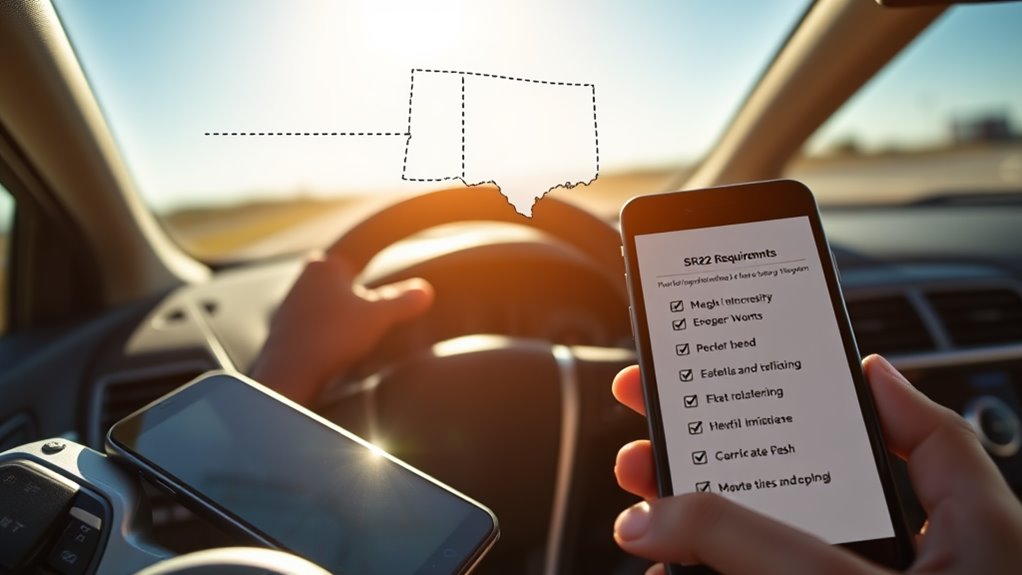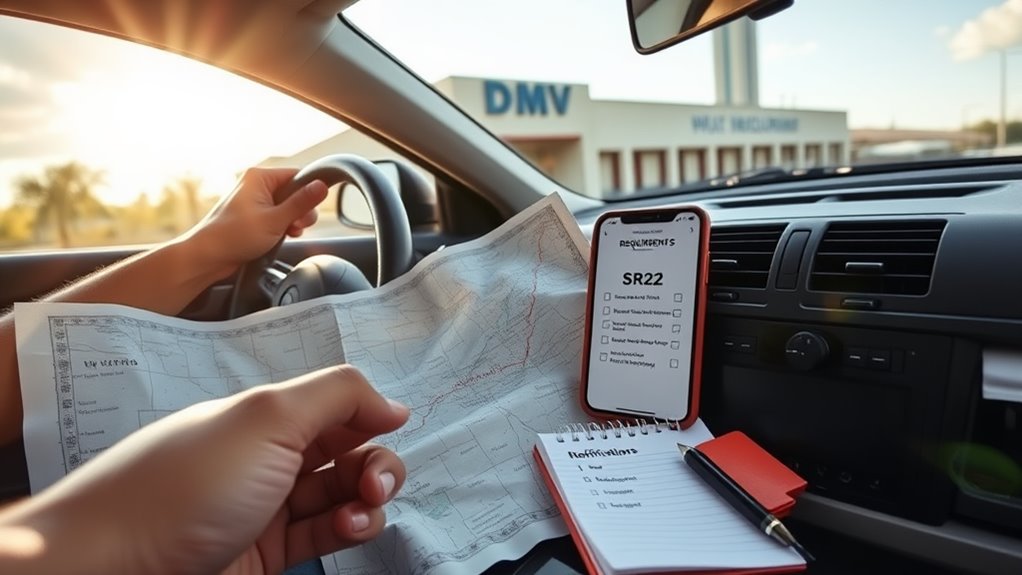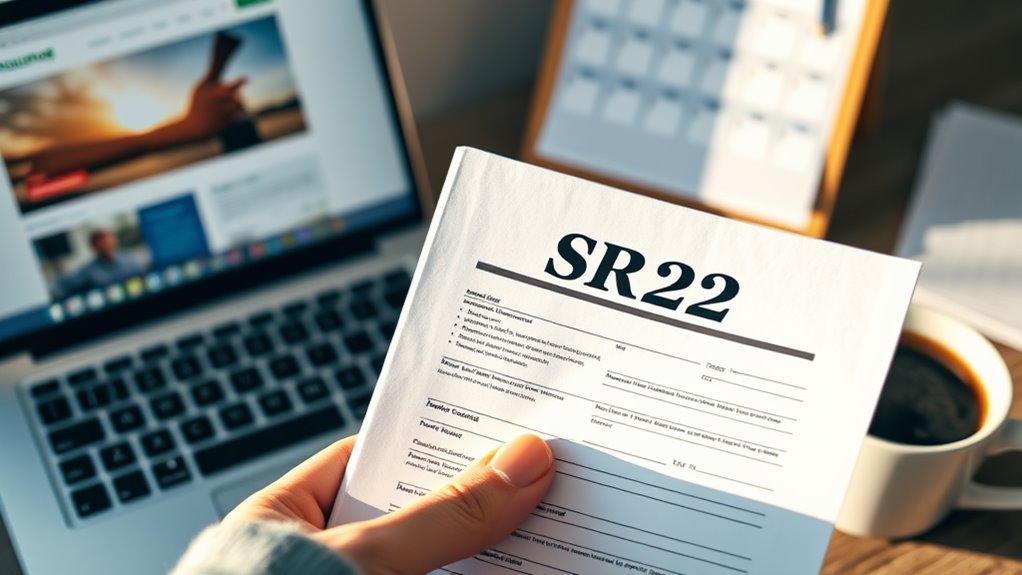Maneuvering the world of SR22 bonds can be tricky, especially for out-of-state drivers. Each state has unique requirements that can impact your coverage and costs. To make the process smoother, there are key tips you should keep in mind. Understanding your home state's regulations is just the beginning. Discover how to secure the best options for your situation and avoid potential pitfalls.
Key Takeaways
- Research SR22 requirements in both your current and former state to ensure compliance with regulations.
- Shop around for insurance providers that specialize in SR22 bonds to find the best rates and coverage.
- Maintain continuous SR22 coverage during your move to avoid penalties or license suspension.
- Notify the DMV in both states about your residency change and any necessary SR22 filings.
- Consider non-owner SR22 policies if you don't own a vehicle but need to meet state requirements.
Understand Your State's SR22 Requirements

When you're managing the complexities of SR22 requirements, it's essential to understand that these regulations can vary greatly from state to state.
Most states require SR22 for one to three years, but some, like Arkansas, may impose longer durations based on multiple offenses. For instance, Alabama, Alaska, and Arizona generally require it for three years, while Connecticut and North Dakota only mandate one year. The specific duration of SR22 requirements can significantly impact your insurance rates and driving privileges.
Eligibility for SR22 typically arises from DUI convictions, driving without insurance, or serious traffic violations like reckless driving. If your license is suspended, you'll need an SR22 to reinstate your driving privileges. Additionally, the duration of SR22 requirements often depends on the severity of the offenses leading to its filing, making it crucial to remain informed about your specific situation.
Eligibility for SR22 often stems from DUI convictions, uninsured driving, or serious traffic violations, essential for license reinstatement.
Always check your state's specific requirements to guarantee compliance and avoid penalties.
Shop Around for Insurance Providers
After understanding your state's SR22 requirements, it's time to focus on finding the right insurance provider.
Start by researching companies known for offering affordable SR22 insurance, like Geico and Erie, which provide competitive rates. Progressive and State Farm also offer thorough coverage and excellent customer service.
Consider factors that affect pricing, such as your credit history, vehicle type, and age. Don't forget to ask about non-owner policies if you don't own a vehicle; providers like Esurance and Liberty Mutual have options available.
Always compare rates, coverage options, and customer service ratings before making a decision. This approach guarantees you find the best fit for your unique situation while staying compliant with state requirements.
Maintain Continuous Coverage During Transition
To guarantee a smooth shift between states, it's crucial to maintain continuous SR22 coverage throughout the process.
Even if you're moving to a state without SR22 requirements, your SR22 must remain active in your old state until its original termination date. This means you can't let your coverage lapse, as failing to do so can lead to severe penalties, including license suspension.
Contact your current insurance provider for guidance on maintaining your SR22 while relocating. You may need to find a new insurer licensed in both states to handle the SR22 filing.
Overlapping policies for a short period can also help confirm that you're continuously covered during your move. Keep your documentation updated to avoid any violations.
Notify DMV of Changes Promptly

Notifying the DMV of your move is essential, especially if you have an active SR-22 requirement.
Moving doesn't cancel your obligation; you'll need to maintain compliance. Inform both the DMV and your insurance provider about your change in residency to avoid complications.
Moving does not eliminate your responsibilities; keep both the DMV and your insurer informed to ensure compliance.
Some states may require cross-state SR-22 filings, so check your new state's specific requirements. Since existing policies may not transfer, you might need to secure a new insurance policy that meets your new state's standards.
Remember, failing to notify the DMV can lead to license suspension or penalties. Stay proactive to guarantee continuous coverage and compliance throughout your shift.
Keeping documentation updated helps you avoid unnecessary legal issues.
Consider Non-Owner SR22 Policies if Applicable
If you're moving to a new state and don't own a vehicle, considering a non-owner SR22 policy could be a smart choice.
These policies are designed for high-risk drivers who need to maintain insurance coverage without owning a car. They provide basic liability coverage, guaranteeing you meet state requirements even when borrowing vehicles.
Non-owner SR22 policies are typically cheaper than standard car insurance, offering flexibility while helping you reinstate your driving privileges.
Just remember, these policies won't cover collision or extensive damage to borrowed vehicles.
To obtain one, compare quotes from insurers that offer non-owner policies and confirm they file the SR22 form with your state's DMV.
Continuous coverage is essential to avoid license suspension.
Conclusion
Steering through the SR22 landscape can feel like sailing through choppy waters, but with the right tools and knowledge, you'll guide smoothly to safety. By understanding your state's requirements, shopping wisely, and keeping coverage continuous, you'll avoid the storm. Remember to inform the DMV of any changes promptly, and if you don't own a vehicle, consider a non-owner policy to save on costs. With these tips, you'll find calm seas on your journey to compliance.








